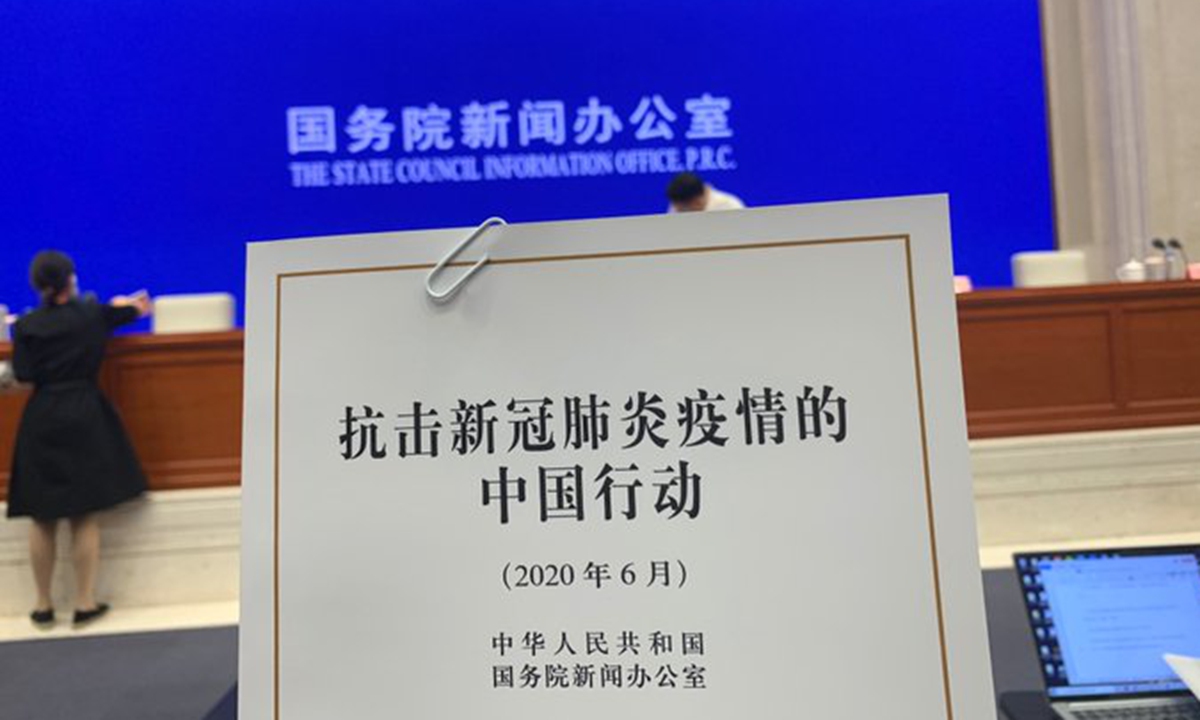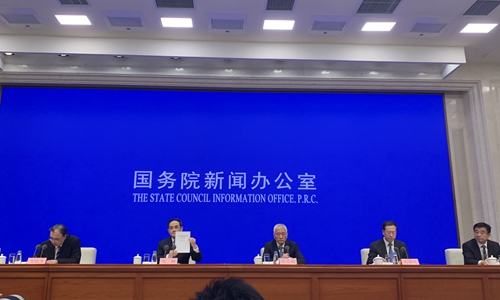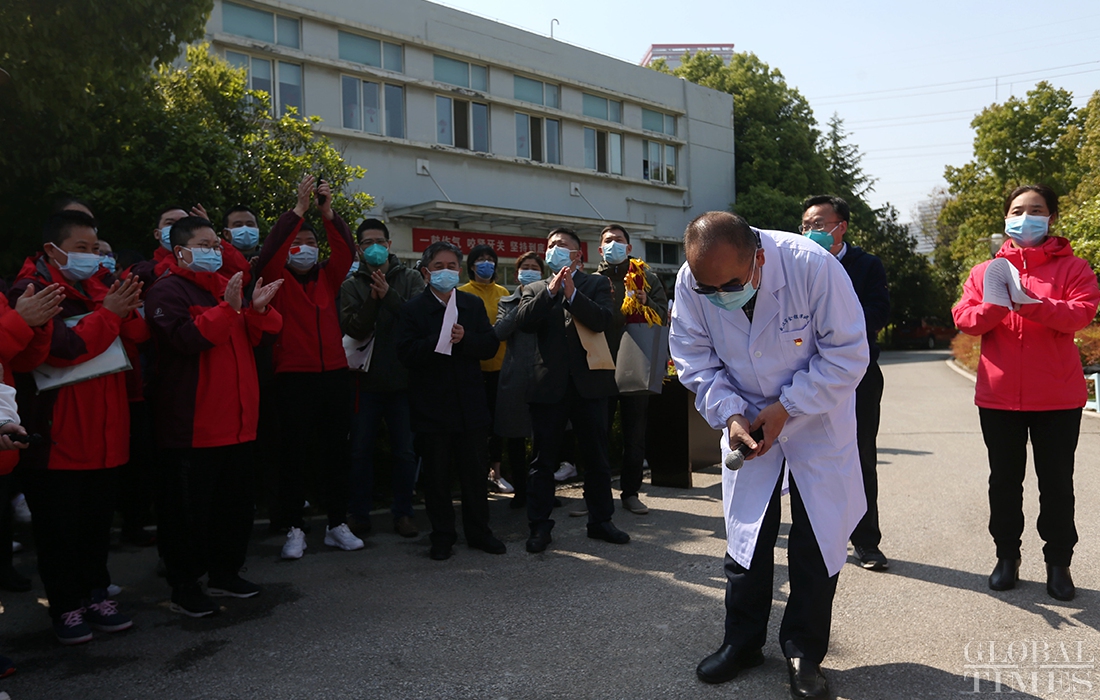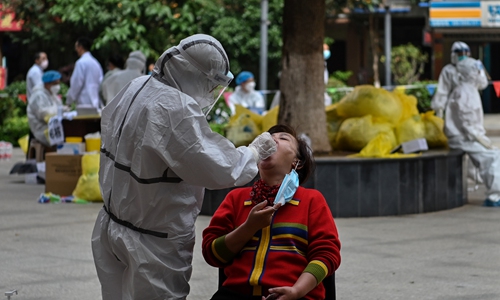China issues white paper on fighting COVID-19

white pape press Photo: GT
China on Sunday published a white paper outlining its detailed steps and measures in fighting the COVID-19 epidemic, which demonstrates to the world how China won the arduous fight.
It also shows how China has timely and effectively curbed the viral spread, delivering a strong rebuke to Western media and politicians' rancorous accusations of China on alleged "cover-up" and "delay" in its response.
The 37,000-word White Paper on fighting COVID-19: China in Action, containing four chapters, was issued to record the Chinese people's battle against the virus, share with the international community China's experience in curbing the virus and clarify China's stance in fighting the virus.
As of May 31, China reported a total of 83,017 confirmed COVID-19 patients, among which 78,307 were discharged from hospital with 4,634 deaths, which makes the country's mortality rate 5.6 percent and a cure rate of 94.3 percent, read a white paper issued by the State Council Information Office on Sunday.
On Thursday, China's hardest-hit Hubei Province accomplished seven "zeros": zero new COVID-19 cases, zero new suspected cases, zero new deaths, zero silent carriers, zero imported cases, zero existing confirmed cases and zero existing suspected cases, the provincial health official said.
"China has a population that accounts for one fifth of the world's total; whilst its infection rate only accounts for two percent of the world," Wu Zunyou, chief epidemiologist at the Chinese Center for Disease Control and Prevention told the Global Times. He said that the white paper came at the time when the viral spread was stalled in China, and it is a summary of China's experience and measures taken in fighting the virus.
The publication of the white paper will also act as China's rebuttal to noise that attempts to smear China's viral battle, said Wu.

A view of a press briefing of the State Council to release the white paper titled "Fighting COVID-19 China in Action" on Sunday. Photo: Li Xuanmin/GT
Timely information-sharing, international cooperation
Since the outbreak, many Western media such as the Associated Press, Wall Street Journal and BBC, along with Western politicians, including US President Donald Trump and US Secretary of State Mike Pompeo, have recklessly accused China of allegedly covering up the viral spread and slowing the response so that the virus could ravage the rest of the world.
A latest rumor that stirred public opinion was report of the Associated Press, which said China's delay in information sharing irked the WHO.
China did not conceal any information about the coronavirus, as some Western media have claimed, Ma Xiaowei, head of the National Health Commission said at the conference launching the white paper on Sunday. It gave the international community the relevant information right away and made significant contributions to global prevention. China identified the genome in just eight days and developed a testing kit in 16 days, according to Ma.
China notified the WHO about the outbreak updates on January 5, one day after it warned the US, and it shared the preliminary research of the virus' etiology to the WHO on January 9. Ever since January 11, China has kept notifying the WHO and other countries on a daily basis, and on January 12, China shared with the WHO about information on the genome sequence of the novel coronavirus.
Wu also rebuked accusations that China delayed sharing of the genome with the WHO. China not only notified the WHO and other countries at the first opportunity; it also shared the genome sequence with the international community at the earliest possible time, said Wu.
China's Vice Foreign Minister Ma Zhaoxu shrugged off the idea that COVID-19 has caused China's relations with the rest of the world to worsen, saying that on the contrary, mutual assistance and the sharing of experience during the pandemic between China and the rest of the world have made relations closer.
He said that China has dispatched 29 medical expert teams to 27 countries to help them fight the virus, and is now providing viral control assistance to 150 countries and four international organizations.

Zhang Dingyu, head of Jinyintan Hospital, bows to the medical team members from Jiangsu Provincial Hospital to show his gratitude in Wuhan on April 12, 2020. Photo: Cui Meng/GT
China has translated its treatment methodology of coronavirus into three languages, distributed it to 180 countries and regions; and Chinese doctors have conducted constant exchanges with their international counterparts, according to the white paper.
US President Trump had praised China's effective and transparent manner in dealing with the virus, but his attitude and that of other US politicians suddenly changed after the US was ravaged by COVID-19. They launched a full-scale blame campaign against China, from the virus' origin to so-called China's cover-up and delayed response. Currently, the US has recorded more infections and deaths than any other country in the world.
Ma Zhaoxu said certain countries are going against historical trends, throwing mud at China for their own failures in controlling the virus, and fabricating and disseminating a political virus. Faced with such wrongdoing, China will firmly fight back, he said.
"They believed they would be fine by cutting all possible connections with China and rest easy, but the US had missed the golden window of opportunity bought by China through hard efforts, and procrastinated in their response to the virus," Li Haidong, a professor from the Institute of International Relations at the China Foreign Affairs University, told the Global Times.
According to the latest media reports, the US has recorded more than 1.8 million coronavirus cases, with recent increases seen in states such as Arizona, Florida and Mississippi. The resumption of economic and social activity, as well as widespread protests against police brutality, continue to raise concerns among some health officials of a further spread.
Hard-won battle
On January 22, Chinese President Xi Jinping gave important instructions that Wuhan and other places in Hubei Province enforce strict restrictions on the movement of people and outbound travel, said the white paper.
After the instruction was issued, 346 national medical teams and 42,600 medical workers had been dispatched to Hubei and Wuhan since January 24, which was dubbed "the biggest medical aid operation since the establishment of the People's Republic of China"; later on February 10, 19 other Chinese provinces and autonomous regions were assigned to help 16 other Hubei cities.
Through the efforts and solidarity of the whole nation, the rest of China, except Hubei, witnessed 10 consecutive days of drop in new infections on February 14; on March 11, new local confirmed cases nationwide slowed to one digit numbers.
Hospitals in Wuhan received over 9,600 cases in critical condition, and the cure rate increased from 14 percent to 89 percent; for those who suffered from underlying diseases, medical workers made specific plans for everyone, once there is hope, they never gave up, reads the white paper.
By comparison, a cohort published in May in The Lancet saying that of 257 critically ill New York City residents treated at two Manhattan hospitals, 39 percent died.
After Wuhan imposed a lockdown, China used only one incubation period to see new infections reach a tipping point, thanks to the Chinese people's cooperation with the government and assistance from across the country to help Wuhan and Hubei, said Wang Guangfa, a respiratory expert at Peking University First Hospital.
China is willing to promote international cooperation and will make a vaccine a global public good when it is available, as the country previously promised, Wang Zhigang, the director of China's Ministry of Science and Technology, said at the press conference.
Five COVID-19 vaccines have so far reportedly entered into clinical trials in China. Some experts predict that China may be the first country in the world to successfully achieve large scale production of a coronavirus vaccine.
Moreover, the white paper said China's COVID-19 patients can receive free treatment. A total of 58,000 people has been received by hospitals nationwide, which cost 1.35 billion yuan ($191 million). Patient in severe condition each costs more than 150,000 yuan in average, some in critical condition even cost up to a million yuan, and the expense will be paid by government, reads the white paper.

A medical worker takes a swab sample from a man being tested for the COVID-19 in Wuhan,Central China's Hubei Province, on Friday. Photo: AFP
Wang Guangfa said he had talked to Bruce Aylward, a Canadian epidemiologist who led the WHO-China Joint Mission on COVID-19 in February while the latter was researching in Wuhan.
"He and other WHO experts were holding an objective view but tinted with little suspicion regarding China before they came… Mr. Aylward asked if we deliberately showed him the well-equipped hospitals when we showed him the designated hospitals for COVID-19 patients in Wuhan. But we told him that those designated hospitals were newly-built and well-equipped," Wang Guangfa said.
Aylward said at a news conference in Geneva on Feb 26 that China had been investing massively on disease control and treatment that is even unreachable for Europe.
He stunned skeptics on China's resources to treat patients by saying he would want to be treated in China if he caught the virus.